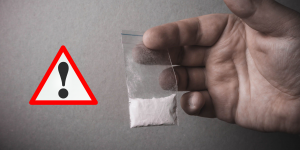
⚠️ DRUG ALERT ⚠️ – Novel synthetic opioid being sold as ketamine
Protonitazene is a novel synthetic opioid Opioids are central nervous system depressants. They typically produce a range of effects including sedation,…
Vaping is a method of consuming drugs using a battery-powered handheld vaporiser, commonly called a vape. This article will focus on nicotine vapes—also called electronic cigarettes or e-cigarettes—however other substances can also be vaped, including cannabis and DMT. Vapes contain a heating element (e.g., a coil) which vaporises a solution of nicotine, propylene glycol (a.k.a. “PG”), glycerine (a.k.a. glycerol or “VG” as in vegetable glycerine), water and flavourings.1 PG and glycerine act as carriers for the nicotine and flavourings.2 This solution is called e-liquid.

The major components of vaporised nicotine alongside water and flavourings.
There are two main types of vapes: closed systems (which include disposable vapes and pre-filled pod vapes), and open systems (which include refillable pod vapes, vape pens and box mods).3 Disposables are single-use pre-filled vapes, whereas pod vapes and open systems are reusable and rechargeable.4 Box mods are generally larger, more powerful, and have adjustable settings (e.g., temperature or wattage).4 Additionally, there are two types of nicotine used for vaping: nicotine salt and nicotine freebase.4 Nicotine salt can be vaped using low power vapes such as disposables, pod vapes or vape pens, whereas freebase requires a more powerful vape such as a box mod.4 See the “effects” and “dosing” sections below for more information on the differences between these forms of nicotine.
Versions of vapes were commercialised as early as 1979, but never became popular.5 The modern nicotine vape was first created by a Chinese pharmacist in 2003 as a safer alternative to smoking.2 The Juul, a type of nicotine vape, was released in the US in 2015 and the popularity of vaping increased in subsequent years.2 Since then, numerous brands have released vaping products, and its popularity has continued to rise.2 There is high quality evidence from many studies that vaping is more effective than nicotine replacement therapy (e.g. patches or gum) for helping people to quit smoking.6 In Australia, vaping is used as a second-line aid for people attempting to quit smoking and can be prescribed by authorised practitioners, but some formulations can be purchased over-the-counter at pharmacies as of 1 October 2024.3,7
Governments across the world have raised concerns about the potential negative impacts of the sale and use of vapes, but regulatory responses have been highly varied.8 Vapes are still unregulated in some countries, but many governments have placed varying levels of restrictions on vaping (e.g. age restrictions, prescription only, flavour bans or outright bans).8
The regulatory landscape of vaping in Australia is changing rapidly. As of 1 July 2024, the Australian Therapeutic Goods Administration (TGA) banned the sale of vapes outside of pharmacies.7 This means vapes can no longer be sold in tobacconists, vape shops, and convenience stores.7 The government’s initial plan was to indefinitely restrict vapes to prescription only, but as of 1 October 2024, vapes with a concentration of 20 mg/mL or less will be available from pharmacies without a prescription for people over the age of 18.7,9 The only permitted flavours under the new laws are mint, menthol and tobacco.7
Vaping has been a subject of controversy in Australia, centring on its yet-unknown long-term health impacts and the government’s response to its increasing popularity. As of 1 July 2024, the TGA has banned the sale of vapes outside of pharmacies.7 This is in an attempt to restrict vaping to therapeutic purposes, namely smoking cessation.7 It is important to note that legality is not the same as safety. For instance, many legal drugs (e.g., alcohol and tobacco) are more harmful to the user and those around them than some illegal drugs (e.g., psilocybin).10

Toxic byproducts produced when PG and glycerine break down in vape aerosol.
In the short-term, vaping may cause lung inflammation and increase a person’s susceptibility to lung infections.2,5 However, due to the long time between a person’s exposure to carcinogens and the development of cancer, the negative long-term effects of vaping may not be known for years.11 This has raised concerns about the possibility of vapes causing lung cancer many years down the line.11 The major components of e-liquid (namely, PG and glycerine) are nontoxic, but when they are heated, they form small amounts of carcinogenic compounds such as acetaldehyde, formaldehyde and acrolein.2 However, vape aerosols contain fewer such toxic chemicals than tobacco smoke and the temperatures required to produce significant levels of these byproducts often produce an aversive taste and are thus unfavourable to users.1,2 Ensuring you do not vape at excessively high temperatures (e.g., by correctly adjusting the settings on a box mod) may minimise the production of these toxic byproducts.1
The evidence suggests that vaping is less harmful than smoking.1,4 Studies have found that people who vape show lower levels of carcinogens and toxins in their bodily fluids than people who smoke.1 There is also some evidence that markers of health improve for people who switch from smoking to vaping, including blood pressure and asthma.1 However, the differences in long-term health impacts between smoking and vaping will likely not be known for years.1
The many different flavours included in vapes may have unintended health impacts, but there is little evidence that particular flavours are more harmful than others.1 Some research suggests that cinnamon flavour, chocolate flavour and flavours containing diacetyl may be more harmful than others, however these flavours have already been banned in many countries.1,2,4,5 While it is unclear whether flavourings (specific or generally) increase the harms associated with vaping, opting for unflavoured vapes may reduce the possibility of harm.
A few years ago, there were concerns of vapes causing a condition known as bronchiolitis obliterans or “popcorn lung” (so-named because of an outbreak amongst popcorn factory workers in 2002).5 Popcorn lung is caused by the chemical diacetyl, which was detected in some e-liquid flavourings.1 However, the amount of diacetyl detected was hundreds of times lower than levels observed in cigarette smoke.1 No cases of popcorn lung have been linked to smoking or vaping, and most e-liquid manufacturers now avoid diacetyl.1,4
In 2019, there were over 2000 reported cases of vaping-related lung injury and 68 deaths.5 This was an outbreak of a new condition which was called E-cigarette or Vaping Use-Associated Lung Injury (EVALI).5 94% of people who suffered from EVALI required hospitalisation but most recovered without long-term damage.5 The outbreak of EVALI was strongly linked to vapes containing black-market cannabis oils which contained the contaminant vitamin E acetate.4 No cases of EVALI have been linked to commercial nicotine vapes.4
The exact effects of drugs can vary depending on the person’s unique biology, the type of nicotine used, and the person’s tolerance level. The immediate effects of inhaling nicotine typically include:12
The effects of vaporised nicotine typically appear within a few seconds and peak for approximately 2-5 minutes.12 The effects start to come down after the peak and last approximately 1-3 hours in total.12
The effects of nicotine can vary depending on the type of nicotine used.3 Below is a comparison of the differences between nicotine salt and freebase.
Nicotine salt:3
Nicotine freebase:3
The strength of a nicotine dose depends on various factors, including a person’s tolerance level and the type of nicotine used (i.e., salt or freebase).3 In vapes, the concentration of nicotine in the e-liquid determines the relative strength of each puff. However, the amount of nicotine consumed and absorbed by a person does not depend on the nicotine concentration alone.13 For example, researchers speculate that open systems (e.g. box mods) may more efficiently aerosolise the e-liquid than closed systems (e.g. disposables) leading to a greater nicotine concentration per puff.13
Importantly, several studies have observed that people often adjust their behaviour according to the concentration of nicotine in the vape.14-16. Namely, people with a high tolerance for nicotine often increase the number of puffs they inhale to achieve the same dose of nicotine when using low concentration e-liquids.14-16 In this case, the larger volume of e-liquid inhaled can increase the user’s exposure to harmful byproducts such as formaldehyde and acetaldehyde.14-16 Hence, for people who vape regularly, vaping with higher concentrations of nicotine may be less harmful because the user consumes less e-liquid to achieve the same intensity of effects.
In general, lower concentrations may be better suited to those who use nicotine infrequently or for light smokers transitioning to vaping.3 Higher concentrations are better suited for those who use nicotine frequently or for heavy smokers transitioning to vaping.3
Unfortunately, many commercial disposable vapes and pre-filled pod vapes do not state the nicotine concentration in their e-liquid. Hence, it is best to start at a low dose and wait before redosing to avoid an accidental overdose (start low and go slow). For more experienced vapers, mixing one’s own e-liquid allows for maximal control over the concentration of nicotine.
Under the laws coming into effect in Australia on 1 October 2024, vapes with a concentration of 20 mg/mL or less will be available from pharmacies without a prescription for people over the age of 18.7 Vapes with a concentration of greater than 20 mg/mL will require a prescription from a medical or nurse practitioner.7
The following is an approximate concentration guide for nicotine salt:3
LOW CONCENTRATION – 20-30 mg/mL
HIGH CONCENTRATION – 20-50 mg/mL
The nicotine concentration should not exceed 60-100 mg/mL due to risk of poisoning.3,13
The following is an approximate concentration guide for nicotine freebase:3
LOW CONCENTRATION – 3-12 mg/mL
HIGH CONCENTRATION – 6-18 mg/mL
Lower nicotine concentrations are used for direct-to-lung vaping, usually 3-6 mg/mL.3 Higher concentrations of nicotine freebase may lead to throat irritation.3
Nicotine can cause some unpleasant effects when high doses are inhaled. These include:17
Mild overdose generally resolves on its own, but you should seek emergency medical attention (call 000) if you are concerned or the person who is vaping has any of the following symptoms:17
Drinking e-liquid carries a very high risk of overdose and can be fatal.17 Do not drink e-liquid, and store it in a place that children cannot access.4,17 E-liquid can be absorbed through the skin, so do not allow it to make contact with your body.17
[2] https://doi.org/10.1146/annurev-pharmtox-042921-084202
[3] https://www1.racgp.org.au/ajgp/2022/july/an-update-on-vaping-and-nicotine-prescribing
[5] https://doi.org/10.1136/bmj-2021-065997
[6] https://doi.org/10.1002%2F14651858.CD010216.pub7
[7] https://www.tga.gov.au/news/media-releases/new-vaping-laws-commence-1-july-2024
[8] https://datawrapper.dwcdn.net/OtJqS/12/
[9] https://www.tga.gov.au/news/media-releases/new-regulation-vapes-starting-january-2024
[10] https://doi.org/10.1016/S0140-6736(10)61462-6
[11] https://doi.org/10.1016/j.lungcan.2020.12.030
[12] https://psychonautwiki.org/wiki/Nicotine
[13] https://doi.org/10.1016/j.toxrep.2020.12.016
[14] https://doi.org/10.1038/s41598-020-63292-1
[15] https://doi.org/10.1093/ntr/ntad050
[16] https://doi.org/10.1111/add.14271
[17] https://www.healthline.com/health/nicotine-poisoning
Written by Darcy Lynch

Protonitazene is a novel synthetic opioid Opioids are central nervous system depressants. They typically produce a range of effects including sedation,…

About α-PVP or “Flakka” α-PVP (pronounced alpha-PVP, short for alpha-PyrrolidinoValeroPhenone, also known as flakka, gravel, grind, the zombie drug, or…

Joint media release by ACTCOSS, CAHMA and ATODA, Thursday 9 June 2022 The ACT Council of Social Service (ACTCOSS), the…